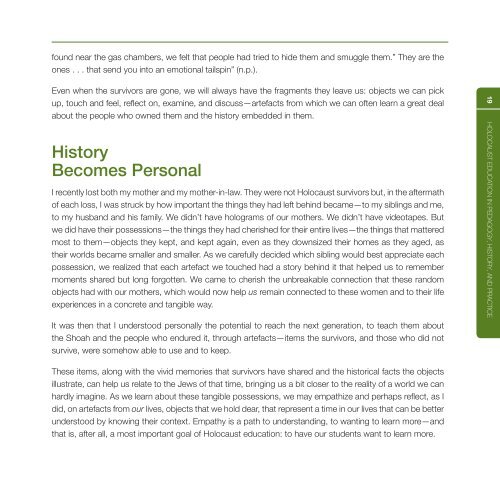2kNreeJ
2kNreeJ
2kNreeJ
Create successful ePaper yourself
Turn your PDF publications into a flip-book with our unique Google optimized e-Paper software.
found near the gas chambers, we felt that people had tried to hide them and smuggle them.” They are the<br />
ones . . . that send you into an emotional tailspin” (n.p.).<br />
Even when the survivors are gone, we will always have the fragments they leave us: objects we can pick<br />
up, touch and feel, reflect on, examine, and discuss—artefacts from which we can often learn a great deal<br />
about the people who owned them and the history embedded in them.<br />
History<br />
Becomes Personal<br />
I recently lost both my mother and my mother-in-law. They were not Holocaust survivors but, in the aftermath<br />
of each loss, I was struck by how important the things they had left behind became—to my siblings and me,<br />
to my husband and his family. We didn’t have holograms of our mothers. We didn’t have videotapes. But<br />
we did have their possessions—the things they had cherished for their entire lives—the things that mattered<br />
most to them—objects they kept, and kept again, even as they downsized their homes as they aged, as<br />
their worlds became smaller and smaller. As we carefully decided which sibling would best appreciate each<br />
possession, we realized that each artefact we touched had a story behind it that helped us to remember<br />
moments shared but long forgotten. We came to cherish the unbreakable connection that these random<br />
objects had with our mothers, which would now help us remain connected to these women and to their life<br />
experiences in a concrete and tangible way.<br />
It was then that I understood personally the potential to reach the next generation, to teach them about<br />
the Shoah and the people who endured it, through artefacts—items the survivors, and those who did not<br />
survive, were somehow able to use and to keep.<br />
19 HOLOCAUST EDUCATION IN PEDAGOGY, HISTORY, AND PRACTICE<br />
These items, along with the vivid memories that survivors have shared and the historical facts the objects<br />
illustrate, can help us relate to the Jews of that time, bringing us a bit closer to the reality of a world we can<br />
hardly imagine. As we learn about these tangible possessions, we may empathize and perhaps reflect, as I<br />
did, on artefacts from our lives, objects that we hold dear, that represent a time in our lives that can be better<br />
understood by knowing their context. Empathy is a path to understanding, to wanting to learn more—and<br />
that is, after all, a most important goal of Holocaust education: to have our students want to learn more.


